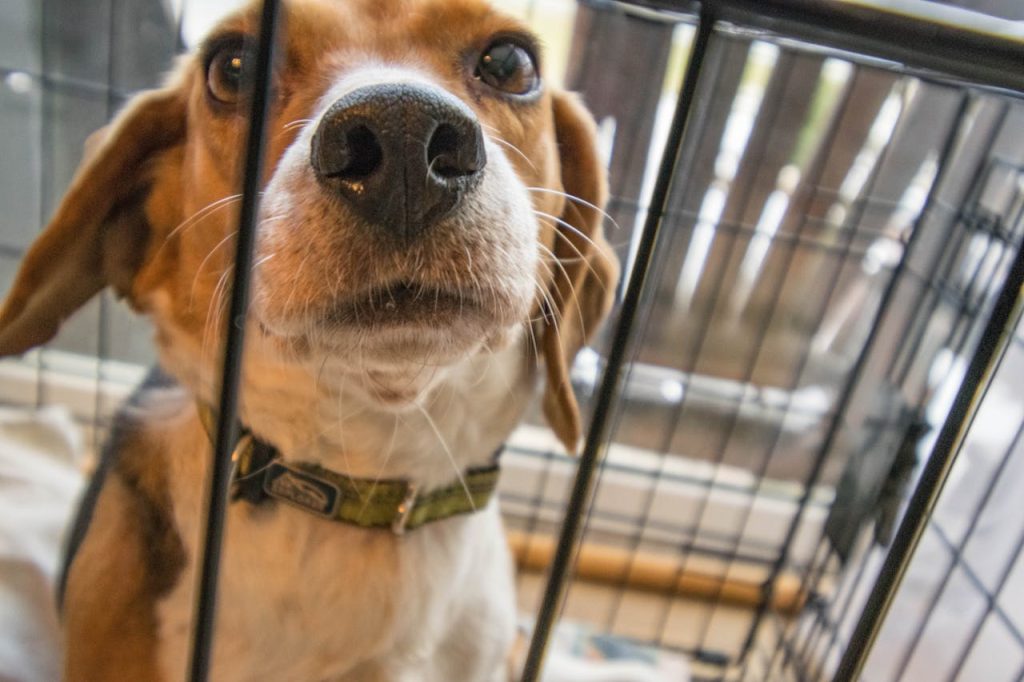
15 Gentle Fixes When Your Dog Hates Crate Time
You’ve tried cozy bedding, treats, and a cheerful “go to your crate!”—but your dog still barks, whines, or resists every time. If your dog hates crate time, you’re not alone. Crating can feel like confinement to some pups, especially if they haven’t built positive associations with it yet.
The good news? With a gentle approach, crate training doesn’t have to feel like punishment. These 15 fixes are perfect for apartment dogs, sensitive pups, or rescues learning to trust again. Let’s turn crate time from dreaded to welcomed—one small step at a time.
1. Start With the Door Open
For a dog who hates the crate, even seeing the door shut can trigger anxiety. Begin with the crate door wide open and encourage your dog to explore it voluntarily. Toss treats inside or feed their meals near or inside the crate to build positive associations.
Never rush to close the door—your dog needs to see the crate as a safe zone, not a trap. This builds confidence and curiosity, not fear.
2. Use a High-Value Treat or Frozen Kong
If your dog dashes out of the crate instantly or refuses to enter, offer a long-lasting reward. A frozen peanut butter Kong or puzzle toy placed at the back of the crate encourages calm behavior and distracts from fear or fussing.
This works especially well during short crate sessions while you’re home. Over time, it rewires how your dog emotionally responds to crate time.
3. Avoid Using the Crate for Time-Outs
If your dog associates the crate with punishment—like being shut in after barking or chewing—it’s no wonder they resist. A dog hates crate time when it feels like rejection or isolation.
Instead, use calm redirection outside the crate and reserve the crate for naps, snacks, and downtime—not discipline. Emotional neutrality is key to building trust.
4. Place the Crate in a Quiet, Cozy Corner
A noisy hallway or high-traffic area can make crate time feel chaotic or unsafe. Dogs are den animals—they crave a peaceful, enclosed space to decompress.
Move the crate to a quiet room or drape it with a breathable cover to make it feel more like a hideout. For apartment living, choose a corner away from loud appliances or street-facing windows.
5. Gradually Increase Crate Duration
Don’t go from zero to hours overnight. If your dog hates crate time, even a few minutes can feel like too much. Start with 1–2 minute intervals while you’re nearby, and slowly build up from there.
Pair crate time with a treat, praise, and calm release. Rushing to let them out while they whine reinforces anxiety. Wait for a pause, then reward quiet behavior.
6. Add Something That Smells Like You
Dogs find comfort in their guardian’s scent. Try placing a worn T-shirt or blanket with your scent into the crate to help ease anxiety and make the space more familiar.
This trick can be especially helpful at bedtime or when you're away. Just be sure the item is safe from chewing and free of toxic detergents or loose strings.
7. Avoid Using the Crate Only When You Leave
If crate time always means you're about to leave, your dog may associate it with abandonment. This creates panic and can lead to destructive behavior or nonstop barking.
Mix it up by encouraging short, positive crate sessions while you're still home—during a movie, meal, or reading time—so the crate doesn’t feel like a goodbye cue.
8. Crate Train in Short, Fun Bursts
Instead of marathon crate sessions, break training into bite-sized games. Toss a treat in, say "crate," and let them go in and out freely. Celebrate with praise or a belly rub each time they enter voluntarily.
These small wins help reinforce a sense of choice—key for a dog who hates crate confinement. Keep sessions upbeat and pressure-free.
9. Play Calming Music or Use a White Noise Machine
Some dogs react poorly to apartment noises—elevators, footsteps, or hallway chatter. A white noise machine or soothing music playlist can create a peaceful environment in and around the crate.
This trick also helps dogs prone to nighttime crate anxiety. Pair sound therapy with a favorite chew or comfort toy for better results.
10. Try a Different Crate Style
Not all crates feel the same. A wire crate may feel too open, while a plastic one might feel too stuffy. Some dogs do better in soft-sided or furniture-style crates with more comfort or concealment.
If your dog panics in one type of crate, try another that better matches their temperament. A different style can change the whole experience.
11. Use Scent Calming Aids
Pheromone sprays and diffusers like Adaptil can reduce stress in crate-resistant dogs. These mimic natural canine calming scents that help lower anxiety.
Spray a blanket or crate pad lightly (never directly on your dog), or plug a diffuser near the crate area. You may notice quicker relaxation during training sessions.
12. Tire Them Out Before Crate Time
A tired dog is a calmer dog. If your dog has pent-up energy, crate time becomes a battle. A brisk walk, training game, or play session beforehand helps them settle in more easily.
Especially in apartments, even 10–15 minutes of mental or physical exercise can make a huge difference in how well your dog accepts crate rest.
13. Use Positive Cue Words Consistently
Choose a calm, positive cue like “bed” or “crate” and say it every time your dog enters—even if you're luring them with a treat. Consistency teaches your dog what’s expected without adding pressure.
Avoid frustrated tones or corrections—especially if your dog hates crate routines already. The goal is calm repetition paired with rewards.
14. Let Them Come Out Calmly, Not in a Panic
If your dog charges out of the crate as soon as the door opens, pause and wait for calm. Open the door slowly, but only allow them to exit once they’re sitting or quiet.
This teaches your dog that crate time ends on a good note—not a frenzied escape. Over time, it builds patience and reduces negative crate associations.
15. Get Support From a Trainer or Vet
If your dog shows signs of crate-induced panic—excessive drooling, chewing, or vocalizing—professional help may be needed. A vet can rule out anxiety disorders, and a trainer can design a custom plan.
You don’t have to go it alone. For more tips, see the Anti-Cruelty Society’s crate training guide or our own post on crate training apartment dogs.
Final Thoughts
If your dog hates crate time, the most powerful thing you can offer is patience. Each small win—one quiet minute, one calm entry—adds up. Keep sessions short, positive, and pressure-free.
With time, your pup can go from resisting the crate to seeking it out as their favorite chill zone. You’ve got this—and so does your dog.
Frequently Asked Questions
Why does my dog hate crate time so much?
Some dogs associate the crate with punishment, loneliness, or fear—especially if they’ve been confined too long or had a negative experience. It may also feel too loud, exposed, or unfamiliar in your home setup.
Is it bad to force a dog into the crate?
Yes. Forcing your dog into a crate can increase anxiety and worsen crate refusal. A slow, reward-based approach works best, especially for dogs who already hate the crate.
How long does it take for a dog to get used to the crate?
It depends on your dog’s personality and past experiences. Some adjust in days, while others need weeks of gentle conditioning. Consistency, patience, and positive reinforcement are key.
Should I ignore whining or barking in the crate?
Brief whining during adjustment is normal. Wait for a quiet moment before releasing your dog to avoid reinforcing the noise. But if the distress is intense or prolonged, it’s better to go slower and reassess your training plan.
What if my dog still hates crate time after trying everything?
If crate resistance persists, consult a positive reinforcement trainer or your vet. Some dogs may benefit from crate alternatives or anxiety treatment tailored to their needs.

Join the Busy Pet Parent Newsletter!
Get easy routines, time-saving tips, and the latest gear reviews—delivered straight to your inbox.
Perfect for busy pet owners, apartment dwellers, and anyone who wants a happy, healthy companion (without the stress).
Exclusive guides & checklists
Product recommendations & deals
No spam—unsubscribe anytime!




